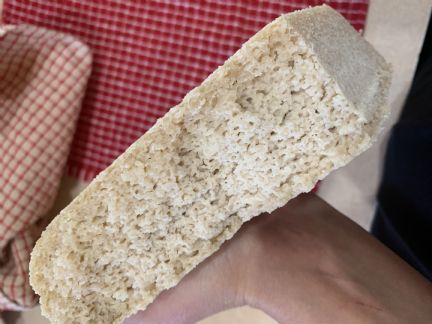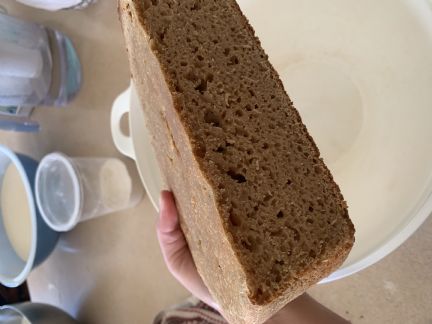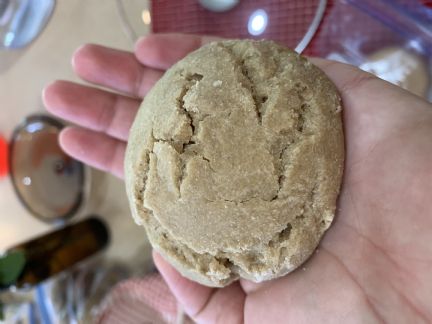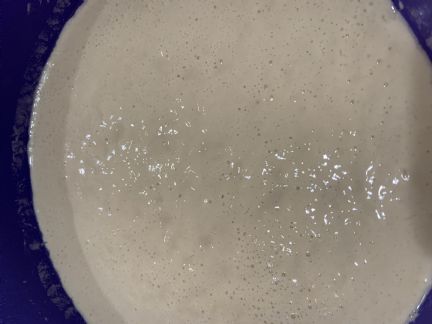| T O P I C R E V I E W |
| Ekahler |
Posted - Jul 21 2022 : 11:51:02 AM
Hi there,
I’ve accumulated quite a number of questions as I’ve been going along. I’ve made some things I love so much and some that I’m not sure if they’re quite right but it’s been an exciting process!
First, I’m at the 4 week point with most of my starters and tried the fridge test for the brown rice, quinoa, and white whole wheat yesterday. Are you supposed to feed the mother and then do the test or just do the test first thing in the morning? I tried it without feeding and all starters were as dead seeming as ever. So I started over, feeding first, and the rice and quinoa looked like they rose like 2/3 more than their fridge counterparts. The white whole wheat didn’t seem to be doing it’s thing so well… I’m going to give them another week and maybe try to increase feedings since the temperatures are pretty warm. But just wanted to clarify if they were supposed to be pre fed or not.
Now, today we had a bit of a tragedy. My brother was feeding the “babies” as we call them (since they haven’t graduated to the fridge yet haha) and he accidentally fed the wrong flour to the wrong one—unbleached flour into quinoa, so the quinoa was lost because it is contaminated with gluten now. I was so sad! I’m going to be leaving soon and will need to leave my family to take over the sourdoughs but my hopes had been to get them all well established and tested out before I left so they would not be difficult to continue. I can’t really start another quinoa from scratch right now but it’s one we’ve really enjoyed as a gluten free flour since it’s matured and I’m wondering… is it at all possible to take a little brown rice starter and feed it quinoa from now on and turn it into a quinoa one? Like would that even have any chance of working or be totally impossible?
Next question… we’ve really enjoyed some of the beginner recipes like the pizza crust and English muffins. Once the mothers move to the fridge, is there still a way to make those beginner recipes or not?
And last, how important is it to keep all commercial yeast products away? And what actually happens if you don’t? I’ve failed there a bit… when I baked other bread in the beginning, I tried setting the mothers on the porch, but eventually decided that wasn’t a safe place for them and there are too many to put them all in the fridge too. So I gave up. They seem to be doing fine—but I’m not sure if I’ve hurt them and just don’t know what they actually should be like?
I think that’s all for now!
Thanks! |
| 5 L A T E S T R E P L I E S (Newest First) |
| Ashley |
Posted - Aug 01 2022 : 1:32:03 PM
I think your hunch that you're adding too much flour to the brown rice is likely. Brown rice is tricky—it takes its time absorbing water, so it's really easy to think you need more flour. I would try scaling back, and if it's possible to get a finer texture to your home-milled flours, I think that would help.
Based on the picture of your whole wheat loaf from a few weeks back, it looks like it has a good start but still needs more time to really loft. Is this a flour that you're also milling yourself and having trouble dialing in the right amount of flour to add? And how is the flavor of the loaf?
The white flour rolls seem like they have a similar thing going on—it looks like there is yeast activity, just not quite enough oomph to really produce lofty breads yet. I did just read and respond to your other post though and it looks like your white flour mother came through this week! |
| Ekahler |
Posted - Jul 28 2022 : 10:18:17 PM

Does that picture show up for you? It’s of the brown rice batter bread I made.

And this is of the white whole wheat one I made a few weeks ago.

This is one of the rolls I made with the white whole wheat this week. Just a little doughy seeming inside, though well cooked.

And this is my unbleached mother. Bake day #5 is tomorrow and today it didn’t pass it’s fridge test.
I hope the picture upload fine and the visuals can help some!
Also, sorry for all the typos in that last post! Should be definitely instead of defiantly and tried instead of tired, etc… |
| Ekahler |
Posted - Jul 28 2022 : 10:06:10 PM
So I have some updates on progress here… the quinoa mother did pretty well with the fridge test this week. It didn’t maybe quite double, but looked great and so I put it into the fridge. After being in there for not even 24 hours, it is defiantly doubled in size and looks amazing. I have consistently been noticing that it has that nice mixture of different sized bubbles so I feel pretty good about it. I haven’t tired another batter bread though… but the English muffins, pizza crust, and rolls all seemed really good. Though the rolls do have egg which might have contributed to the good rise? I put the brown rice into the fridge too. It wasn’t quite as happy looking as the quinoa, but seemed pretty close. It hasn’t quite double in size but has mostly filled the pint jar I am keeping it in. But I made batter bread with it yesterday and it was disgusting. So I’m definitely second guessing myself. Mostly, it was SO dense and dry. Now I definitely fault myself to some degree there because I didn’t do a full recipe and I’m horrible at even following them then. I added too much flour I think. I’ve had trouble with the amount of flour that is called for being too little so I add more to get that thickened cream cheese texture, but then it was a little thick. I was super excited to see it rising nicely though, but then at some point it leveled off and didn’t rise more and baking didn’t help. So these are my thoughts: I’m milling my own flour and it is a bit gritty. I was reading another post someone made about rice flours and you mentioned that it sometimes takes longer to absorb water which makes total sense. I’ve been finding that my mother behaves a lot better when I add a little less than 1/4 cup to it. If I add the whole 1/4 cup, it develops a layer of standing water on top of it that seems to inhibit its activity a bit. When i reduce the water just a bit, that layer of extra water goes away and the mother noticeable inflates each day and when i stir it, it is bubbly inside. What I’m thinking is that if I am not milling it to be fine enough, it will not absorb the water as well. The same would hold for when I go to mix up a recipe—it will seem like it needs more flour. Then when I go to bake, the heat will allow those coarser grains to absorb the liquid and I’ll be left with a super dry final product. What do you think? Is that possible or am I off track? And do you think the mother needs to come out of the fridge and back to the counter for a while?
Also, those gluten flours don’t seem to be nearly as happy. I had baked batter bread with the white whole wheat a few weeks back and was really encouraged to see it rise as predicted, but it still seems really dense when backed, even though it has bubbles. Is that normal? But neither of the gluten flours come even close to passing the fridge test. They don’t rise at all. And the bubbles seem pretty uniform. I have increased feedings due to hot temperatures, but it doesn’t seem to do much good. I’m afraid the problem is the presence of commercial yeast. I also have a family who relies a lot on bread, so I have admittedly had it around a lot. I don’t know how to get away from it. But the quinoa mother is doing so well. If it is doing well but the gluten ones aren’t, shouldn’t the presence of other yeast not be the problem since it’s a factor all the mothers have in common?
Thanks so much for helping me troubleshoot! I really appreciate it. |
| Ekahler |
Posted - Jul 22 2022 : 4:42:32 PM
Hi Ashley
Thank you so much for your response! It helps a lot. I’m excited to try things out and see how it goes. Hoping I can get those starters moved off the counter soon…!
|
| Ashley |
Posted - Jul 21 2022 : 3:08:28 PM
Hi Ellie,
Feeding the mother and then doing the test is best. Also, if your mother doesn't "pass" the test, but has been reliably yielding loaves with good rise in a predictable amount of time, chances are it's ready to be converted to a refrigerator mother.
I'm sorry the hear about your quinoa mother (but also happy to hear that its flavor improved as it matured). To give your new quinoa mother a boost, I would definitely recommend starting with a little brown rice flour.
You can absolutely continue make recipes from the Beginner Breads Section even though you've moved on to the Advanced Breads Section. Here's a link to a post where I gave general instructions on how I make Beginner Breads with a refrigerator mother: http://www.wildbread.net/topic.asp?TOPIC_ID=176
Lastly, keeping yeasted breads away from your mother is good to do when you're in the counter mother phase because your counter mother is pulling yeasts and good bacteria in from the surrounding air. The presence of commercially yeasted breads can interfere, but a couple close encounters aren't going to make or break your mothers.  |
|
|